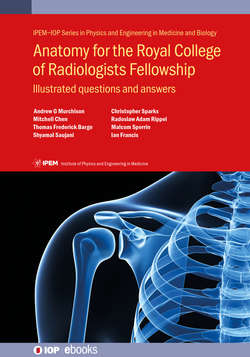Читать книгу Anatomy for the Royal College of Radiologists Fellowship - Malcolm Sperrin - Страница 16
На сайте Литреса книга снята с продажи.
Q1.8 Axial image from T2-weighted sequence of MRI brain
Оглавление1 Name the arrowed structure.
2 Name the arrowed structure.
3 Name the arrowed structure.
4 Name the arrowed structure.
5 Name the arrowed structure.
Answers
1 Left external capsule.
2 Posterior limb of the left internal capsule.
3 Right extreme capsule.
4 Right claustrum.
5 Head of the left caudate nucleus.
Comments:
The basal ganglia are deep (i.e. not at the cortical surface) grey matter structures. The paired caudate nuclei are tucked in beside the lateral ventricles—they are comma-shaped, with the bulbous head of the caudate nucleus anteriorly. The other main structure in the basal ganglia is the lentiform nucleus comprising the putamen and the globus pallidus (these are not distinguishable on the image in this question). This is separated from the caudate nucleus by the internal capsule. The internal capsule is a white matter structure which is a major avenue of communication between the cortex and the lower CNS; for example, the corticospinal tract passes through it. It is divided into three parts—the anterior limb (between the lentiform nucleus and caudate nucleus) and the posterior limb (between the lentiform nucleus and thalamus), which are connected by the genu (‘knee’).
Beyond the lentiform nucleus is an onion-skin of structures—the external capsule (a white matter tract) beyond which is the claustrum (a strip of grey matter). Next along is another white matter tract, the extreme capsule, followed by the insular cortex.
Exam tips:
The axial view through the basal ganglia is another exam classic. Also make sure to be familiar with the anatomy in coronal views.
Cavum septum pellucidum and cavum vergae are often shown on coronal sections—look out for these if the question asks for an anatomical variant.
